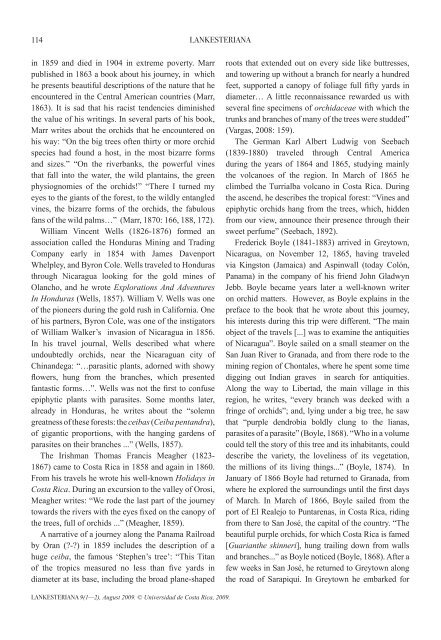orchids and orchidology in central america. 500 ... - lankesteriana.org
orchids and orchidology in central america. 500 ... - lankesteriana.org
orchids and orchidology in central america. 500 ... - lankesteriana.org
You also want an ePaper? Increase the reach of your titles
YUMPU automatically turns print PDFs into web optimized ePapers that Google loves.
114<br />
<strong>in</strong> 1859 <strong>and</strong> died <strong>in</strong> 1904 <strong>in</strong> extreme poverty. Marr<br />
published <strong>in</strong> 1863 a book about his journey, <strong>in</strong> which<br />
he presents beautiful descriptions of the nature that he<br />
encountered <strong>in</strong> the Central American countries (Marr,<br />
1863). It is sad that his racist tendencies dim<strong>in</strong>ished<br />
the value of his writ<strong>in</strong>gs. In several parts of his book,<br />
Marr writes about the <strong>orchids</strong> that he encountered on<br />
his way: “On the big trees often thirty or more orchid<br />
species had found a host, <strong>in</strong> the most bizarre forms<br />
<strong>and</strong> sizes.” “On the riverbanks, the powerful v<strong>in</strong>es<br />
that fall <strong>in</strong>to the water, the wild planta<strong>in</strong>s, the green<br />
physiognomies of the <strong>orchids</strong>!” “There I turned my<br />
eyes to the giants of the forest, to the wildly entangled<br />
v<strong>in</strong>es, the bizarre forms of the <strong>orchids</strong>, the fabulous<br />
fans of the wild palms…” (Marr, 1870: 166, 188, 172).<br />
William V<strong>in</strong>cent Wells (1826-1876) formed an<br />
association called the Honduras M<strong>in</strong><strong>in</strong>g <strong>and</strong> Trad<strong>in</strong>g<br />
Company early <strong>in</strong> 1854 with James Davenport<br />
Whelpley, <strong>and</strong> Byron Cole. Wells traveled to Honduras<br />
through Nicaragua look<strong>in</strong>g for the gold m<strong>in</strong>es of<br />
Olancho, <strong>and</strong> he wrote Explorations And Adventures<br />
In Honduras (Wells, 1857). William V. Wells was one<br />
of the pioneers dur<strong>in</strong>g the gold rush <strong>in</strong> California. One<br />
of his partners, Byron Cole, was one of the <strong>in</strong>stigators<br />
of William Walker’s <strong>in</strong>vasion of Nicaragua <strong>in</strong> 1856.<br />
In his travel journal, Wells described what where<br />
undoubtedly <strong>orchids</strong>, near the Nicaraguan city of<br />
Ch<strong>in</strong><strong>and</strong>ega: “…parasitic plants, adorned with showy<br />
flowers, hung from the branches, which presented<br />
fantastic forms…”. Wells was not the first to confuse<br />
epiphytic plants with parasites. Some months later,<br />
already <strong>in</strong> Honduras, he writes about the “solemn<br />
greatness of these forests: the ceibas (Ceiba pent<strong>and</strong>ra),<br />
of gigantic proportions, with the hang<strong>in</strong>g gardens of<br />
parasites on their branches ...” (Wells, 1857).<br />
The Irishman Thomas Francis Meagher (1823-<br />
1867) came to Costa Rica <strong>in</strong> 1858 <strong>and</strong> aga<strong>in</strong> <strong>in</strong> 1860.<br />
From his travels he wrote his well-known Holidays <strong>in</strong><br />
Costa Rica. Dur<strong>in</strong>g an excursion to the valley of Orosi,<br />
Meagher writes: “We rode the last part of the journey<br />
towards the rivers with the eyes fixed on the canopy of<br />
the trees, full of <strong>orchids</strong> ...” (Meagher, 1859).<br />
A narrative of a journey along the Panama Railroad<br />
by Oran (?-?) <strong>in</strong> 1859 <strong>in</strong>cludes the description of a<br />
huge ceiba, the famous ‘Stephen’s tree’: “This Titan<br />
of the tropics measured no less than five yards <strong>in</strong><br />
diameter at its base, <strong>in</strong>clud<strong>in</strong>g the broad plane-shaped<br />
LANKESTERIANA<br />
LANKESTERIANA 9(1—2), August 2009. © Universidad de Costa Rica, 2009.<br />
roots that extended out on every side like buttresses,<br />
<strong>and</strong> tower<strong>in</strong>g up without a branch for nearly a hundred<br />
feet, supported a canopy of foliage full fifty yards <strong>in</strong><br />
diameter… A little reconnaissance rewarded us with<br />
several f<strong>in</strong>e specimens of orchidaceae with which the<br />
trunks <strong>and</strong> branches of many of the trees were studded”<br />
(Vargas, 2008: 159).<br />
The German Karl Albert Ludwig von Seebach<br />
(1839-1880) traveled through Central America<br />
dur<strong>in</strong>g the years of 1864 <strong>and</strong> 1865, study<strong>in</strong>g ma<strong>in</strong>ly<br />
the volcanoes of the region. In March of 1865 he<br />
climbed the Turrialba volcano <strong>in</strong> Costa Rica. Dur<strong>in</strong>g<br />
the ascend, he describes the tropical forest: “V<strong>in</strong>es <strong>and</strong><br />
epiphytic <strong>orchids</strong> hang from the trees, which, hidden<br />
from our view, announce their presence through their<br />
sweet perfume” (Seebach, 1892).<br />
Frederick Boyle (1841-1883) arrived <strong>in</strong> Greytown,<br />
Nicaragua, on November 12, 1865, hav<strong>in</strong>g traveled<br />
via K<strong>in</strong>gston (Jamaica) <strong>and</strong> Asp<strong>in</strong>wall (today Colón,<br />
Panama) <strong>in</strong> the company of his friend John Gladwyn<br />
Jebb. Boyle became years later a well-known writer<br />
on orchid matters. However, as Boyle expla<strong>in</strong>s <strong>in</strong> the<br />
preface to the book that he wrote about this journey,<br />
his <strong>in</strong>terests dur<strong>in</strong>g this trip were different. “The ma<strong>in</strong><br />
object of the travels [...] was to exam<strong>in</strong>e the antiquities<br />
of Nicaragua”. Boyle sailed on a small steamer on the<br />
San Juan River to Granada, <strong>and</strong> from there rode to the<br />
m<strong>in</strong><strong>in</strong>g region of Chontales, where he spent some time<br />
digg<strong>in</strong>g out Indian graves <strong>in</strong> search for antiquities.<br />
Along the way to Libertad, the ma<strong>in</strong> village <strong>in</strong> this<br />
region, he writes, “every branch was decked with a<br />
fr<strong>in</strong>ge of <strong>orchids</strong>”; <strong>and</strong>, ly<strong>in</strong>g under a big tree, he saw<br />
that “purple dendrobia boldly clung to the lianas,<br />
parasites of a parasite” (Boyle, 1868). “Who <strong>in</strong> a volume<br />
could tell the story of this tree <strong>and</strong> its <strong>in</strong>habitants, could<br />
describe the variety, the lovel<strong>in</strong>ess of its vegetation,<br />
the millions of its liv<strong>in</strong>g th<strong>in</strong>gs...” (Boyle, 1874). In<br />
January of 1866 Boyle had returned to Granada, from<br />
where he explored the surround<strong>in</strong>gs until the first days<br />
of March. In March of 1866, Boyle sailed from the<br />
port of El Realejo to Puntarenas, <strong>in</strong> Costa Rica, rid<strong>in</strong>g<br />
from there to San José, the capital of the country. “The<br />
beautiful purple <strong>orchids</strong>, for which Costa Rica is famed<br />
[Guarianthe sk<strong>in</strong>neri], hung trail<strong>in</strong>g down from walls<br />
<strong>and</strong> branches...” as Boyle noticed (Boyle, 1868). After a<br />
few weeks <strong>in</strong> San José, he returned to Greytown along<br />
the road of Sarapiquí. In Greytown he embarked for
















